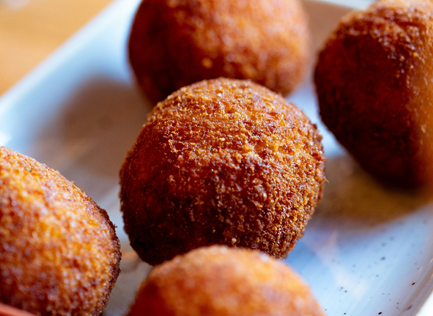

The history of Arancini, the popular Sicilian street food, is a fascinating tale of culinary evolution. The exact origins (and even the name) of this dish are hotly debated, adding an element of mystery and intrigue to its story. Its delicious simplicity has made it a popular choice not just in Italy but also beyond its borders.
The rice base of the dish with the use of saffron as the primary spice leads historians to surmise that early versions of the dish may have come into being during Arab rule of the island of Sicily in the Middle Ages, around the 10th century when rice was introduced to the island. A popular Arab cookbook written in 1226 by Muhammad al-Baghdadi contains a recipe very similar to Arancini Nãranjìya, which describes a meatball dipped in beaten eggs and fried to resemble an orange, lends credence to this theory. Kibbeh, a type of fried meatball formed from ground meat and bulgar, could have also been an inspiration for Arancini. Considering that Sicily was a place of trade and cultural exchange throughout history, other theories trace its roots back to the Normans, Spaniards, or even the ancient Greeks. It is commonly believed that the step of covering the rice balls in breadcrumbs before frying them was an innovation by the court of Holy Roman Emperor Frederick II. It is said that in an attempt to preserve the rice balls for transport, they were covered in breadcrumbs and then fried; a great way to preserve them and also to make them extra tasty!


Due to linguistic variances in the Sicilian dialect, the correct name of the dish is also debated. The fact that the dish is named after a fruit can be traced directly to Arab cultural traditions, where round-shaped foods were named after fruits. However, depending on where you are in Sicily, you may call this dish either arancinu or arancina. While this difference may seem small and unimportant to English speakers, it creates quite a confusion when translating the word into Italian. This is because if you believe the true name of the dish is arancinu in Sicilian, derived from Vulgar Latin, you would adopt the masculine arancino in Italian or the plural arancini. On the other hand, some believe that since the dish is named for its resemblance to an orange, Italian grammatical rules should be followed when naming the dish. In Italian, fruit trees themselves are referred to in the masculine (arancio), but the fruit itself is referred to in the feminine (arancia), meaning the dish would be called arancina or arancine (plural). The Accademia della Crusca (the Italian Authority on Italian language and grammar) ruled that both the masculine and feminine forms are correct, however, Italian dictionaries nationally and internationally use the masculine arancino. In Sicily, though, you could hear either version depending on where you are.
No matter the exact origin of the dish or the name, what you will find today are variations on the theme of a sumptuous and rich fried rice ball. In the eastern part of the island, particularly in Catania, arancini are often cone-shaped to symbolize Mount Etna, the iconic volcano. If you bite off the top corner, the steam that wafts out the top resembles smoke coming out of the crater. Common fillings include ragu (a meat sauce), ham and cheese, and spinach with ricotta. In Palermo, the classic round shape is more prevalent, and they are typically filled with a combination of meat sauce, peas, and mozzarella. Today, chefs and restaurants have reimagined the dish in many ways and often use it as a base to feature typical Sicilian ingredients like pistachios and seafood, and have even created sweet versions filled with chocolate and pistachio cream.
